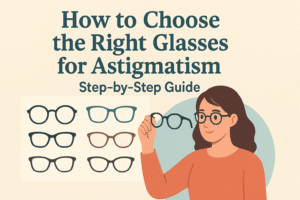If you’ve ever struggled with blurry or distorted vision, you may have asked yourself whether your glasses are really helping. Astigmatism is one of the most common eye conditions, and the right pair of glasses can dramatically improve your clarity and comfort. But here’s the question many patients ask: how do you choose the right glasses for astigmatism?
The answer goes beyond finding frames that look good. It’s about choosing the correct lenses, coatings, and fit after a professional eye exam. With guidance from an experienced optometrist near you, you can select prescription glasses that sharpen your vision and match your lifestyle.
What is Astigmatism?
Astigmatism happens when the cornea or lens of the eye isn’t perfectly round. Instead of being shaped like a smooth basketball, the surface curves unevenly — more like a football. This irregular curve bends light incorrectly, leading to blurry or distorted vision at different distances.
Common symptoms include:
Blurred or fuzzy sight, especially at night
Frequent headaches or eye strain
Squinting to focus on text or screens
It’s possible to have astigmatism alongside nearsightedness or farsightedness. Many people don’t even realize they have it until they book a comprehensive eye exam with an optometrist.
Children can also develop astigmatism, which is why regular children’s eye tests are essential. Uncorrected vision problems in kids may affect school performance and confidence.
The encouraging news is that astigmatism is highly treatable. With the right prescription glasses or contact lenses, most people experience clear, comfortable vision again. Knowing how to choose the right glasses for astigmatism ensures you’re not just seeing better but also protecting your long-term eye health.
Why Glasses Are the Best Solution for Astigmatism
When it comes to correcting astigmatism, glasses are the simplest and most effective choice. Unlike off-the-shelf readers, custom prescription glasses are designed to match your eye’s unique curvature. This accuracy means sharper focus, less distortion, and fewer headaches during daily activities like reading, driving, or using digital devices.
Some patients prefer contact lenses, especially toric lenses made for astigmatism. While these can work well, they often require more maintenance, may be more expensive in the long term, and can cause discomfort if worn for extended periods. Glasses, on the other hand, are low-maintenance, affordable, and provide all-day comfort.
Modern eyewear also features advanced technology. Coatings like anti-reflective, scratch-resistant, and blue-light filters can enhance comfort, especially if you spend long hours at a computer. And let’s not forget — glasses are also a style statement. With the right frames, you get both function and fashion.
By starting with a professional eye exam, your optometrist near you can recommend the ideal prescription. From there, the process of how to choose the right glasses for astigmatism becomes straightforward, resulting in clear, comfortable sight.
How to Choose the Right Glasses for Astigmatism: Step-by-Step Guide
Finding the perfect glasses for astigmatism is easier than you think. Here’s a step-by-step approach:
1. Get a Comprehensive Eye Exam
The foundation of how to choose the right glasses for astigmatism is a thorough eye exam. An optometrist will measure the curve of your cornea, test your clarity, and check for related issues. Accurate results mean your prescription glasses will truly meet your needs.
2. Understand Lens Options
Astigmatism is usually corrected with toric lenses. Depending on your vision, you may need single-vision lenses or progressive lenses if you require multiple distances corrected. Coatings like anti-reflective and blue-light filters can reduce glare and protect your eyes, especially if you use screens frequently.
3. Pick Frames That Work with Your Prescription
The frames you select aren’t just about style. Thicker lenses may need sturdier frames, while lightweight designs suit everyday wear. For kids, durable frames identified during a children’s eye test are essential.
4. Match Glasses to Your Lifestyle
Think about how and when you’ll wear them. If you drive often, night-driving coatings may help. If you play sports, flexible, shatterproof frames may be better. Some people also choose contact lenses as a backup for active days.
5. Consider Insurance and Budget
Vision insurance often covers basic prescription glasses, but extras like coatings or premium frames may require an additional cost. Discussing your options with your optometrist ensures you balance clarity, comfort, and affordability.
By following these steps, you’ll remove the guesswork from how to choose the right glasses for astigmatism and enjoy vision that supports your everyday life.

Other Eye Care Services We Provide
While glasses for astigmatism are important, many patients need broader vision care. Our practice also offers:
Dry eye treatment – Relief for burning, watery, or irritated eyes.
Glaucoma screening – Early detection of this “silent thief of sight.”
Pediatric optometrist services – Myopia management and routine children’s eye tests.
Low vision aids – Magnifiers and devices for those with advanced vision loss.
Regular eye exams don’t just detect astigmatism — they help protect long-term eye health.
Advanced Technology in Astigmatism Care
Today’s optometrists rely on advanced technology to deliver precise results. Tools such as corneal topography, retinal imaging, and OCT scans allow us to map the shape of your eye in detail.
These technologies ensure your prescription is accurate and help detect conditions like glaucoma or macular degeneration early. When it comes to choosing the right glasses for astigmatism, this precision makes all the difference.
Why Choose Our Optometry Practice
Not all practices are the same. Patients choose us because we offer:
Experienced optometrists with advanced training in vision care
A wide selection of stylish, durable prescription glasses
Same-day service for many prescriptions
Family-friendly care, from toddlers’ first eye test to senior eye health
Transparent pricing and insurance support
When you’re deciding how to choose the right glasses for astigmatism, working with a trusted optometrist gives you confidence every step of the way.

Conclusion: Clear Vision Starts with the Right Choice
Living with astigmatism doesn’t mean you have to settle for blurred or strained vision. By taking the time to schedule a professional eye exam, learning about your lens options, and choosing frames that fit your lifestyle, you can make a confident decision about your eyewear. The key is understanding how to choose the right glasses for astigmatism isn’t just about correcting vision — it’s about enhancing your comfort, confidence, and quality of life.
FAQs:
Q1. How do I know if I need glasses for astigmatism?
If you notice blurry or distorted vision, frequent squinting, or headaches, schedule an eye exam. An optometrist near you can confirm if glasses are needed.
Q2. What type of glasses are best for astigmatism?
Toric prescription glasses are most effective. Adding anti-reflective or blue-light coatings can enhance comfort.
Q3. Can contact lenses correct astigmatism instead of glasses?
Yes. Toric contact lenses can correct astigmatism, but glasses are often easier to maintain and more affordable.
Q4. How to choose the right glasses for astigmatism if I work on a computer?
Ask your optometrist for digital lenses with blue-light filters and anti-glare coatings to reduce eye strain.
Q5. Do children with astigmatism need glasses?
Yes. Early correction after a child’s eye test helps prevent academic difficulties and supports healthy vision development.
Q6. Are glasses for astigmatism covered by insurance?
Most vision plans cover eye exams and basic lenses, with options to upgrade frames and coatings.

